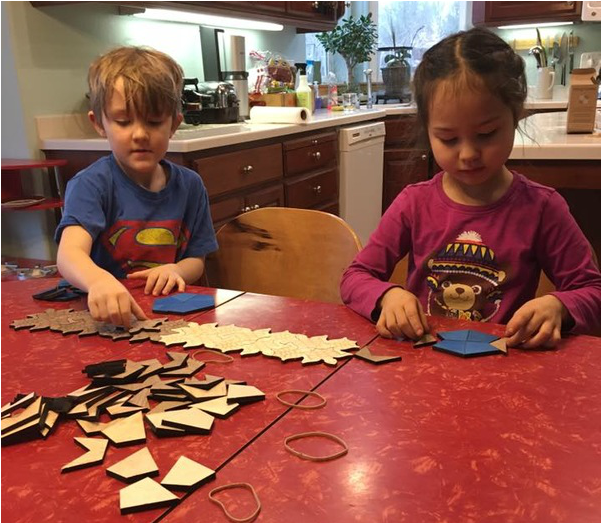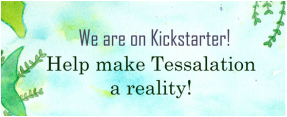Tessalation!
|
Easily the greatest joy of this Kickstarter campaign -- apart from seeing those numbers and the friends' names roll in! -- has been having the tessellators of the world contact me. I was so thrilled to hear from Christopher Danielson, of Talking Math with Kids. I absolutely LOVE his platform: "Parents know they need to read at least 20 minutes a day with our kids. But teaching math to your kids doesn’t have to be intimidating. It can be fun. Just as children say goodnight to the moon, they can say hello to numbers, shapes and measurement." -- Christopher DanielsonChris created the Tessellating Turtles I've been raving about, as well as other non-turtled curriculum tools that I've been using with my kids at home. Here's Christopher's take on why tessellations belong in your lives. Q&A with Christopher: AKA the Tessellating Turtle Guy1. Where does your passion for tessellations come from? It started when my colleague at Normandale Community College, Kevin Lee, left a few scrap turtles lying around near the laser cutter. He was doing some beautiful inlaid woodwork with them. I took a few scrap turtles home, and I had them on the table on our front porch all summer. They were fun for me to tinker with while I worked out there, but I noticed that kids were especially drawn to them. Young children can see that they go together, but it's not at all obvious how. That experience led to them being a centerpiece of Math On-A-Stick—a large-scale family math event at the Minnesota State Fair. There, I watched hundreds of children a day make wonderful and creative patterns for 12 days straight. The interaction with the tessellation is what fascinates me. Of course I love Escher's work, and the beautiful images in your book. But for me, the process is always the most fascinating part. 2. What's so great about tessellations and why should we care about them? Geometry is about organizing space. Playing with tessellations is a fun and interesting way to play with organizing space in a particular way. The more opportunities children have to organize and structure two and three-dimensional space, the richer the ideas they'll form. There are lots of ways to get these opportunities—for example building with blocks, decorating doll houses, putting toy cars in garages, and doing puzzles are all examples of playful ways to practice organizing space. 3. These turtles are amazing to hold in the hand. Can you tell me about the process to create them? I cut them on a laser cutter using 3/16" American hardwood. Each set has some maple and some walnut in order to provide a light/dark contrast that encourages kids to make patterns. Again, I owe a debt to my Normandale colleague Kevin Lee for getting me started using a laser cutter, and for using such nice wood for his artwork. Those original scraps were walnut, and I noticed how nice they felt to touch right away. 4. How would you suggest teachers or parents introduce them to children. Do you have any suggestions for using them in a lesson plan? Let the children play. Four and five year olds sometimes benefit from seeing someone else putting a couple of turtles together. Most older children (and many of the younger ones) will see the potential on their own. Nearly all children are drawn to touch the turtles if you just leave them out in a little pile. Watching children at the State Fair, and then in other venues (including a kindergarten), I notice that as kids play with the turtles they get new ideas, and that these ideas become more complicated over time. This means that a kid who is carefully rotating a turtle to figure out how to fit two of them together is ten minutes later making alternating rows of light and dark turtles, or playing with negative space by leaving turtles out of the design. The main way a parent or teacher can add to the experience is asking gentle questions along the way. Prompts such as "I notice that you're making a pattern. What can you tell me about your pattern?" are helpful in getting children to describe their thinking. The turtles are toys with a deep mathematical structure. Kids notice that structure through their play. There's not really much more needed in order for children to have a productive experience playing with them. 5. Are there more tessellation puzzles on the way? Funny you should mention "puzzle". I don't think of the turtles as a puzzle at all. Puzzles are great fun but they have a predetermined finishing point. You're done once you've filled the frame. Maybe you do the puzzle again, but you end up with the same result. The turtles, by contrast, don't have a specified end. This is sometimes troubling for adults; it rarely is for children. Nearly all children are happy to establish and strive for their own goals, and to have these goals change as they play. I became curious about why so many children at the State Fair were compelled to continue putting more and more turtles together (we had about 200 turtles on a long table). I realized that it's an encounter with infinity. Every time you put in a new turtle, you make room for another one. The process only ends because you run out of turtles—or out of space-- but you can imagine more of each of these. It never ends because you've run out of ideas. Are there more on the way? The short answer is yes. I'm working on a bunch of things. I have become captivated with spiraling polygons. A surprisingly simple pentagon can make a spiral that grows without gaps between the pentagons, covering the plane without the kinds of repetition you see with the turtles and other tessellations. After my friend John Golden got me started with the spiraling pentagons, I wondered what other polygons I could make that work in the same way. It turns out that any number of sides greater than four can make a spiraling polygon of this sort. I have made hexagons, octagons and nonagons using these principles. You may be familiar with Pattern Blocks, which are ubiquitous in American classrooms. I'm working on a new collection of shapes that I'm callling 21st Century Pattern Blocks—a high-design update of the original. These are still in early prototypes, but I've been testing some of the shapes in the set with children in a variety of settings. They're tons of fun, but nothing is quite so approachable as these turtles! How great is this? Thank you, Christopher. You can visit the Kickstarter for Tessalation! here.
0 Comments
Leave a Reply. |
AuthorEmily Grosvenor, author of Tessalation!, a children's book about tesselations and patterns in nature. Archives
October 2022
Categories |


 RSS Feed
RSS Feed
